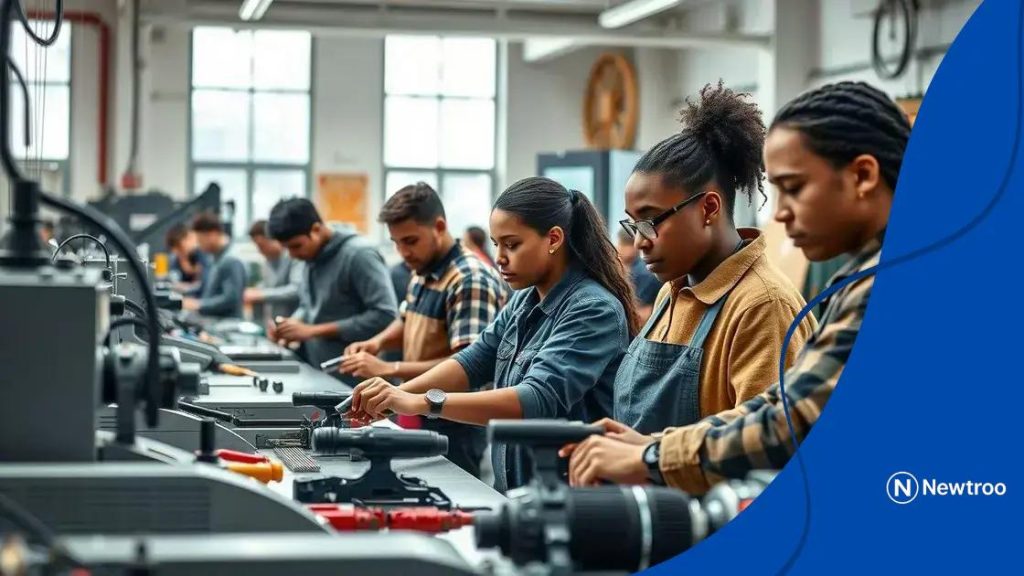Investment in trade schools sees national expansion

Anúncios
Investment in trade schools sees national expansion, providing students with practical skills and direct pathways to employment, while also positively impacting local economies through job creation and industry partnerships.
Investment in trade schools sees national expansion as a vital shift in education and workforce development. With a growing push for skilled labor, many are curious about how these institutions are evolving. What does this mean for future job seekers and industries?
Anúncios
The rise of trade schools: A global perspective
The rise of trade schools is reshaping education systems globally. As the demand for skilled professionals increases, trade schools offer practical training and career pathways that traditional education sometimes overlooks. Students are discovering that hands-on skills are just as valuable as a college degree.
The global trend toward trade education
Trade schools are becoming more popular in many countries. They provide a focused curriculum that prepares students for specific careers. In places like Germany, this model has long been successful, creating a strong link between education and industry needs.
- More students are choosing trade schools over traditional universities.
- Industries are advocating for skilled workers trained in specific fields.
- Government policies are increasingly supporting vocational training programs.
This shift isn’t just occurring in developed nations. Emerging economies are also recognizing the importance of these institutions. For example, in India, trade schools are growing dramatically to meet the needs of a booming economy.
Anúncios
Benefits of trade schools worldwide
Trade schools offer numerous benefits that appeal to students and employers alike. They emphasize real-world skills and often have partnerships with local industries. Graduates from these programs find jobs more quickly than their peers with traditional degrees. This practicality results in a win-win situation for everyone involved.
- Shorter training periods lead to quicker employment.
- Lower student loan debt compared to four-year colleges.
- Hands-on experience prepares students for specific job roles.
As we look at the broader picture, the expansion of trade schools signifies a valuable shift in how society views education and employment. By prioritizing skills over degrees, we are beginning to see a more balanced workforce that meets the needs of various industries. This transformation not only empowers students but also boosts the economy as a whole.
Benefits of trade schools for students
Trade schools provide numerous benefits for students seeking practical skills and career advancement. These institutions focus on teaching essential skills that are directly applicable in the workforce, making education more relevant and effective.
Hands-on learning experience
One major advantage of attending a trade school is the hands-on learning environment. Students engage in practical applications of their studies, which enhances understanding and retention. This approach helps students feel more confident in their abilities and prepares them for real-world challenges.
- Simulated work settings for better learning outcomes.
- Opportunities to work with industry-standard tools and equipment.
- Instructors often have industry experience, offering valuable insights.
The emphasis on tailored programs means that students can focus on specific careers. Whether it’s plumbing, electrical work, or cosmetology, trade schools provide targeted education that quickly prepares students for their chosen field.
Cost efficiency
Another significant benefit is the cost-effectiveness of trade school education. Compared to traditional four-year colleges, trade schools generally charge lower tuition fees. This makes vocational training a more accessible option for many students.
- Shorter programs lead to lower overall educational costs.
- Less student debt compared to university degree programs.
- Quick entry into the workforce means earlier earnings.
Additionally, trade schools often have strong partnerships with local businesses, leading to apprenticeships and job placements. This direct connection with employers can provide students with the chance to gain real-world experience while still in school, enhancing employability upon graduation.
Students who choose trade schools enjoy a focused curriculum that prepares them for specific job roles. As they progress, they acquire not only technical skills but also a strong work ethic and adaptability, making them valuable assets in any industry.
How trade schools impact local economies

Trade schools significantly influence local economies by fostering skilled labor and supporting local businesses. As these institutions grow, they nurture a workforce that meets the needs of various industries, ensuring economic stability and growth.
Job creation and support for businesses
One of the primary effects of trade schools is job creation. When students are trained in specific trades, they become employable in their communities. This influx of skilled workers attracts businesses looking for qualified candidates.
- Local companies can expand with a skilled workforce.
- Increased employment rates boost local spending.
- Trade schools partner with businesses to create tailored training programs.
These partnerships ensure that students learn relevant skills that are in high demand. As a result, trade schools play a crucial role in meeting the labor needs of various sectors, from construction to healthcare.
Economic growth through skilled trades
The presence of trade schools leads to a more qualified workforce, which in turn drives innovation and productivity. Skilled tradespeople often contribute to their local economies by starting their own businesses or improving existing ones.
- Skilled trades help reduce unemployment rates.
- Increased local incomes elevate community living standards.
- Trade schools support economic diversification with various programs.
This dynamic creates a ripple effect; as more individuals acquire skills, the demand for goods and services in the community grows. Communities with vibrant trade schools are often more resilient to economic downturns because they have diversified job opportunities.
Moreover, as students graduate and enter the workforce, they contribute not just through their professions but also by becoming engaged community members. This engagement often includes volunteering, supporting local events, and contributing to local culture and identity.
Challenges faced by trade schools today
Trade schools face several challenges that can hinder their growth and effectiveness. Understanding these obstacles is vital for improving vocational education and meeting the needs of students and industries.
Funding and financial support
One of the most significant issues is securing adequate funding. Many trade schools depend on state and federal budgets, which can fluctuate greatly. When funding is tight, schools may struggle to maintain facilities, hire qualified instructors, and offer comprehensive programs.
- Inconsistent financial support can limit program offerings.
- Upgrading equipment and technology often requires additional funding.
- Scholarships and financial aid can help, but are often insufficient.
As a result, some students might not have access to the latest tools and resources, making it challenging to provide high-quality training.
Changing labor market demands
Trade schools also face the challenge of keeping up with rapidly changing labor market demands. As technology evolves, the skills required for various trades can shift quickly. This constant change may leave some programs outdated or irrelevant.
- Curricula need frequent updates to stay relevant.
- Instructors require ongoing training to teach new skills.
- Employers may have higher expectations that trade schools must meet.
Trade schools must adapt to these changes by collaborating with industries to ensure their training programs align with current job requirements. This can create additional pressure on institutions to remain flexible and innovative.
Moreover, competition from online education platforms poses another challenge. Many students are turning to online programs that offer flexibility and affordability. Trade schools must find ways to highlight the benefits of hands-on training and the unique skills that can only be acquired in a practical setting.
While these challenges are significant, they also present opportunities for improvement and innovation. Addressing funding issues and adapting to market needs can lead to stronger, more effective vocational education options for students.
Future trends in trade education
Future trends in trade education are shaping the way students learn and prepare for careers. As industries evolve, trade schools are also transforming their approaches to meet the changing demands of the workforce.
Incorporation of technology in training
One significant trend is the increasing use of technology in training methods. Trade schools are integrating digital tools and platforms to enhance learning. Students need to be familiar with the latest technologies used in their fields.
- Virtual reality (VR) and augmented reality (AR) provide immersive learning experiences.
- Online courses and blended learning models offer flexibility.
- Industry software is being incorporated into training programs.
This technology integration not only makes learning more engaging but also ensures that students are workforce-ready with the skills that employers demand.
Focus on soft skills development
Another emerging trend is the emphasis on soft skills alongside technical training. Employers are looking for workers who possess strong communication, teamwork, and problem-solving abilities. Trade schools are starting to incorporate these skills into their curricula.
- Workshops that focus on leadership and communication can enhance student profiles.
- Collaboration on projects simulates real workplace dynamics.
- Networking opportunities with local businesses improve employability.
By focusing on soft skills, trade schools are preparing students to succeed not just in technical aspects but also in navigating workplace environments.
A growing trend is also the collaboration between trade schools and industries. Strong partnerships help ensure that what is taught aligns with current job market requirements. These collaborations lead to apprenticeship programs, allowing students to gain hands-on experience while studying. As a result, trade schools can adapt their programs to meet the evolving needs of employers.
The future of trade education looks promising, with a shift towards innovation and a holistic approach to student training. As schools embrace these trends, they are likely to produce graduates who are not only technically skilled but also well-rounded professionals ready to tackle the challenges of the modern workforce.
The future of trade schools is bright as they continue to adapt to changing job markets and technology. By enhancing hands-on training with modern tools and emphasizing soft skills, these institutions are equipping students to thrive in various careers. Partnerships with local businesses ensure that training is relevant and valuable. As we look ahead, the commitment to quality education will help students succeed and meet the demands of employers. Trade education is evolving, and its impact on communities and economies will only grow stronger.
FAQ – Frequently Asked Questions about Trade Schools
What are the key benefits of attending a trade school?
Trade schools offer hands-on training, relevant skills for specific careers, and often have lower tuition costs compared to traditional colleges.
How do trade schools align with local job markets?
Trade schools frequently collaborate with local businesses to ensure that their programs meet the current demands of the job market, providing students with relevant skills.
What challenges do trade schools face today?
Trade schools face challenges such as funding issues, the need to keep up with changing labor market demands, and competition from online education platforms.
How is technology used in trade education?
Technology in trade education includes the use of virtual reality for training, online courses for flexibility, and industry-standard software to enhance learning experiences.